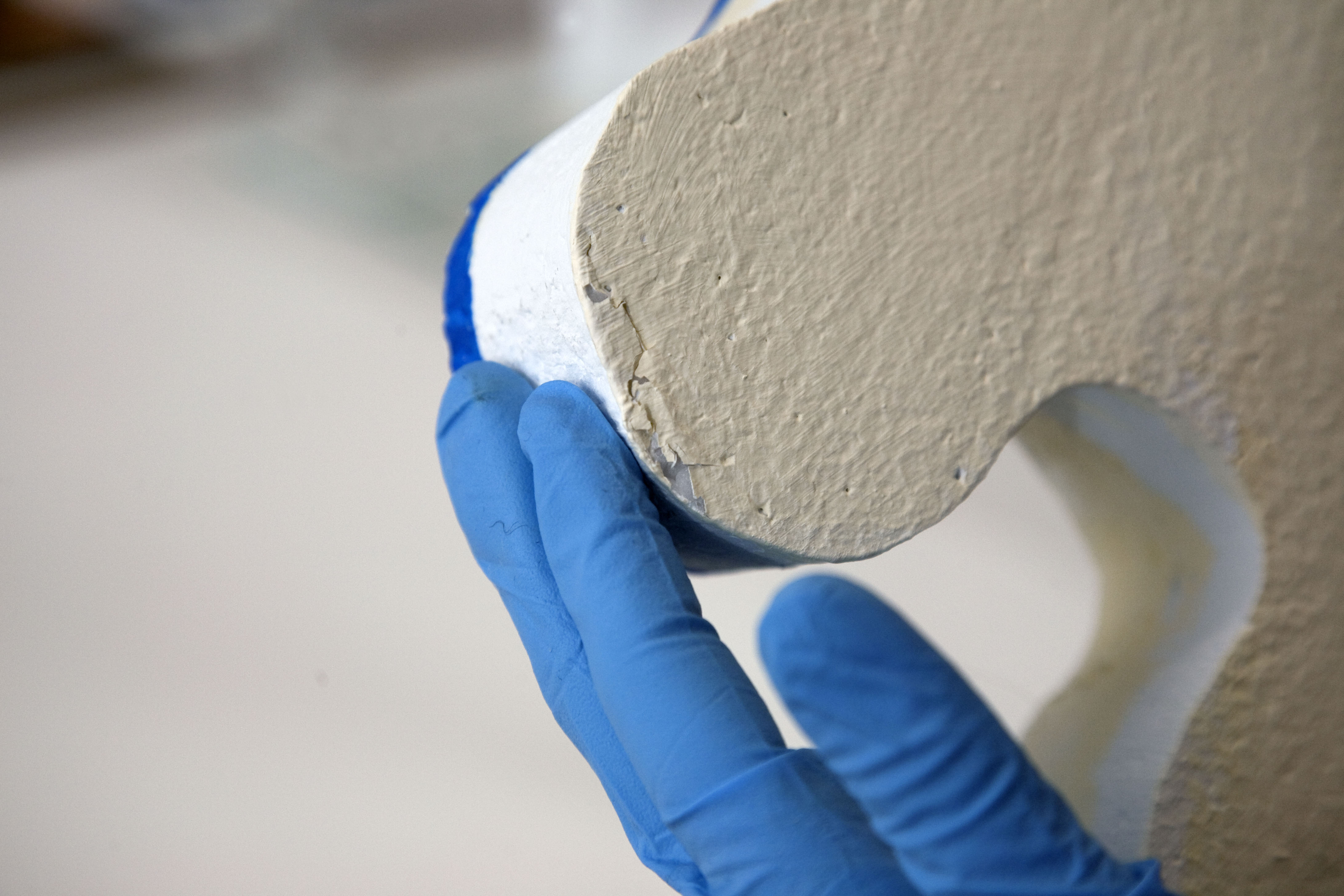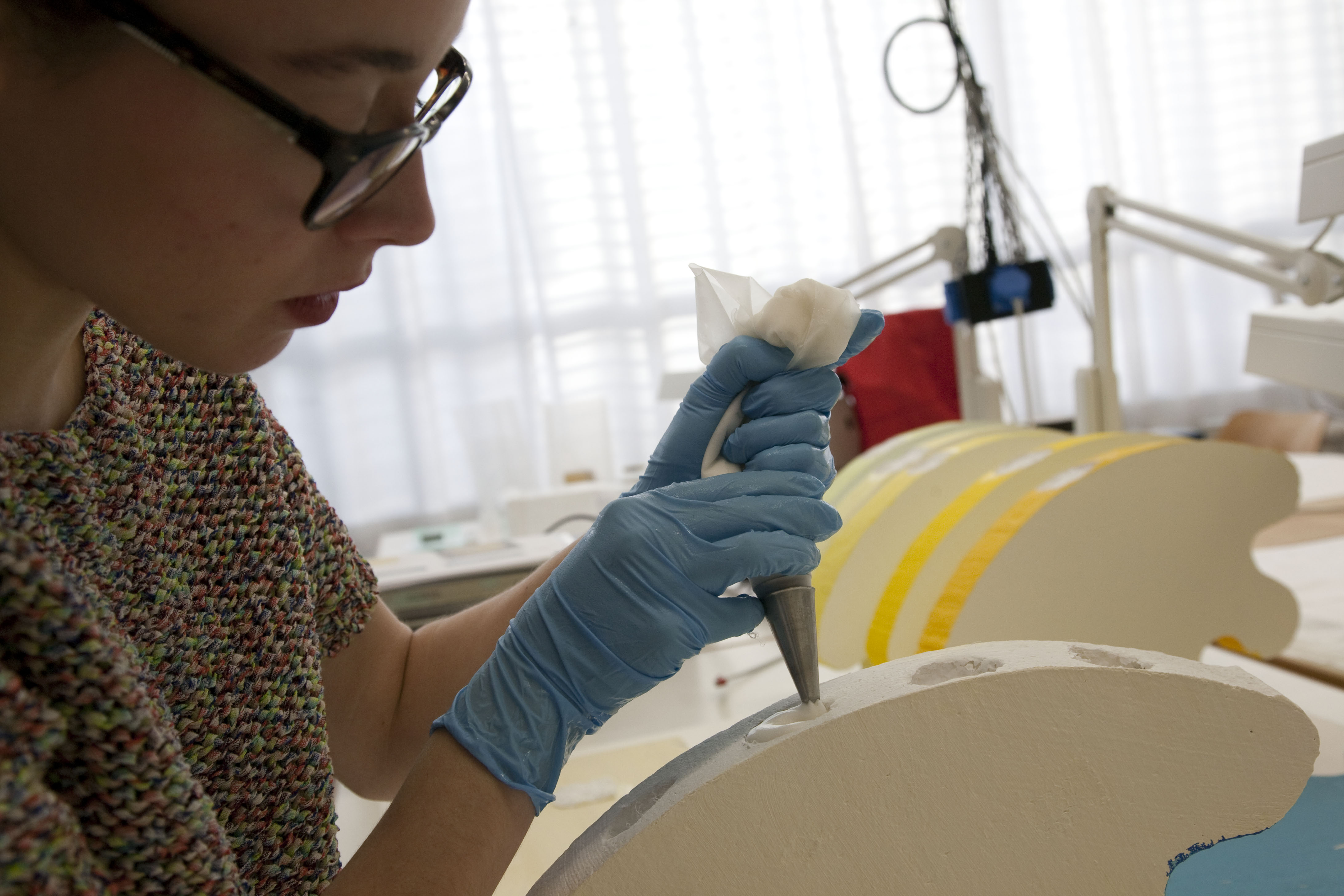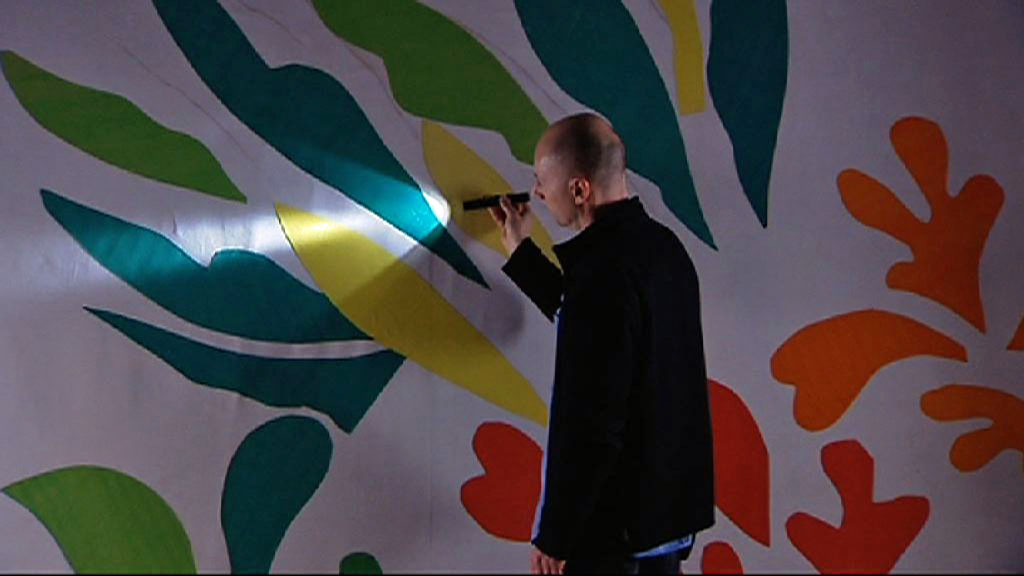Saving contemporary art from self-destruction

Art restoration is facing unprecedented challenges as contemporary art uses unconventional methods and materials that age prematurely or become obsolete. Some works are saved, others are left to self-destruct.
Man-made materials crack, spare parts for sculptures disappear and audio-visual equipment becomes obsolete. The use of untested or degradable materials, new media, performances and conceptual art since the 1970s has transformed the profession of art restoration and introduced new specialisations.
It has also become more complex with questions surfacing of whether all contemporary art should be conserved.
“Every work of art is a new challenge,” Pierre-Antoine Héritier, a Geneva art restorer and leading expert in his field, told swissinfo.ch. The advantage of contemporary art is that artists are often still alive which allows for a dialogue on preservation to take place.
The use of novel materials may make a work of art more vulnerable because we don’t yet know how it will age, but it does not make it more fragile or less valuable, Héritier said. He is presently working on a canvas covered with splattered chewing gum.

More
Modern art preserved for posterity
Damaging conditions
Héritier is more critical of the poor display, storage and transportation conditions that in his opinion are to blame for a lot of damage, especially since art has become so mobile as museums, galleries, collectors and investors compete for recognised artists.
Fungal attacks, spider webs, insect droppings and the use of bubble wrap for transportation, instead of proper encasings, are his worst nightmares.
Although he maintains that his own work has changed very little since he started in 1975, he concedes that younger restorers tend to specialise. His own assistant, Anita Durand, wrote her thesis on the restoration of ephemeral work, like performance art, which only exists in the present moment.
As a result of specialisation, collaboration between different branches has become essential, including with scientists. The New York Metropolitan Museum of Art and MoMA, the Getty in Los Angeles and the Tate Gallery in London have scientists dedicated full-time to finding conservation solutions for unstable materials.
The costs of restoration are therefore rapidly rising, with insurance companies also requiring the presence of expert restorers to assess the condition of a work before and after it has travelled.
Sylvie Ramel-Rouzet, who focuses on art made from plastic, admitted: “Our understanding of the different chemical families that have contributed to man-made materials is never as rapid as their evolution.”
For this reason, she works closely with chemists and curators in order to slow down the process of degradation, for example of sculptures made by the junk sculptor Arman from the 1960s onwards. “We cannot arrest time, we can only slow it down,” she warned.
But not all works of art want to arrest time, Bernard Fibicher, director of the Musée des Beaux-Arts de Lausanne, pointed out. Deterioration is an integral part of Daniel Spoerri’s snare pictures made from leftover meals or Dieter Roth’s chocolate sculptures.
“We have to accept that in 20 to 30 years there will be little left of those pieces,” he explained.
Fibicher stressed the importance of documentation to allow some works to live on. Land art, for example, that is conceived for a specific natural environment and is therefore non-transposable, needs to be documented to survive.
Art restorers today deal with a variety of unstable materials such as polyurethane, petroleum jelly, chocolate, wax, felt, fat, chewing gum, decaying animals, plants or foodstuffs.
They must also address the issues of aging, erosion and corrosion due to the presence of degradable polymers, mechanical movements, electricity, electronics, IT, photography and audiovisual materials.
Infrared microspectroscopy, multispectral high definition digitisation, thermal analysis and photo-elastic analysis are amongst the innovative techniques taught and applied.
Sound restoration has also become a new area of investigation as it is considered an integral part of some sculptures (Tinguely, Calder, etc)
The Tate in Britain has founded a “Time based materials” department to tackle technologies that become obsolete and performance art that disappears.
Listening to artists
Thomas Hirschhorn, the world-famous Swiss artist, was asked by swissinfo.ch what could be done to ensure the longevity of his work.
“My art is made for eternity,” was the answer. Considering that he makes his art from postal wrapping paper and tape, with felt-tip writing that fades with light, scattered with press clippings or magazines that tap into the pulse of his world, the statement comes as a surprise.
That each work of art is made for eternity, as Hirschhorn suggests, is a concept that restorers have to tackle on a daily basis, while dealing with the non-permanence of the materials used.
“Hirschhorn is a good example,” Héritier noted, because he asks the questions art restorers also have to ask themselves.
“A work of art invents time,” Hirschhorn explained.
He was asked if he would agree to have a work of his identically reproduced if it were beyond repair.
“Because my work does not disappear, it must not be reproduced,” he replied.
Other artists think differently and welcome the opportunity to revive or refresh their works, which is essential for restorers to know beforehand. For instance, Damien Hirst supplies an “after-sales service” for his decomposed works and notorious Californian artist Paul McCarthy is only too happy to replace broken elements in his sculptures – not always successfully – with even more shocking ones.
Sarkis, the contemporary conceptual artist whose installations made from various objects and media filled the entire Mamco in Geneva last year, accepts that his work is shaped by the environment in which it is exposed. Curator Sophie Costes explained that the artist considers his installations to be like a music partition that can be played differently each time.

More
Masterpieces meticulously mended
To save or not to save
“Art needs to keep moving and it is our role to keep it alive,” Costes continued, which is why she regrets that Yves Klein’s famous blue monochromes are often shielded by Plexiglas. Although monochromes are amongst the most difficult paintings to restore seamlessly in case of damage, she doesn’t believe it is possible to experience the International Klein Blue, as it has been patented, with a protective glass in between.
“We need to be more open-minded,” she said, but we also have to accept that not all works of art are meant to survive. “If all the art from the past had been preserved, there would never have been any place for anything new.”
Fibicher remembers examining a work by the German Expressionist, Kirchner, with the legendary Bern art merchant, Eberhard Kornfeld. He commented on visible stains, to which Kornfeld replied: “Young man, I see that you already have some grey hair. Everything in life deteriorates. Why not accept the same thing from a work of art?”
Matthew Barney (1967-) American artist making sculptural installations that combine performance and video. His tapioca filled mattresses and petroleum jelly drawings are famously difficult to preserve.
Joseph Beuys (1921-1986) German influential performance theorist whose sculptures covered in dust to indicate the passage of time were until recently still religiously dusted by well-intentioned restorers.
Dan Colen (1979-) Young American artist who uses chewing gum and confetti to create “accidental” canvases that are already a problem for restorers.
Damien Hirst (1965-) When the shark suspended in formaldehyde in his iconic piece ‘The Physical Impossibility of Death in the Mind of Someone Living’ became too decomposed, the British artist simply replaced it.
Dieter Roth (1930-1998) made works of found materials, including chocolate, cheese and worms.
Sarkis (1938-) Turkish-born Armenian conceptual artist living in France. Accepts that his installations can never be identically reproduced.
Daniel Spoerri (1930-) Romania-born Swiss artist known for his snare-pictures, including of eaten meals.

In compliance with the JTI standards
More: SWI swissinfo.ch certified by the Journalism Trust Initiative









You can find an overview of ongoing debates with our journalists here . Please join us!
If you want to start a conversation about a topic raised in this article or want to report factual errors, email us at english@swissinfo.ch.